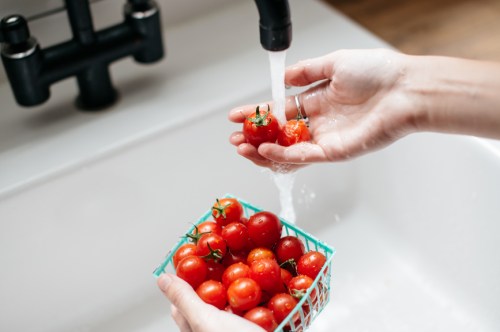Okay, Really: How Gross Is It To Not Wash Produce Before Eating It?
A food science professor explains why washing produce before eating it is necessary and shares the best ways to ensure it’s clean.

Before you grab the shiny red apple sitting in the complementary bowl of fruit and immediately take a big juicy bite, you may want to (*resists every urge to make a cliché Adam and Eve reference*) think again. That’s because, according to a food science professor, it might be best to give it a quick rinse before eating.
Experts in This Article
Director and Professor of in the Department of Food Science &
Of course, we’ve all been there: You’re on the go and feeling peckish, but you realize that you forgot to rinse the Honeycrisp apple you brought in your bag to nosh on. As tempted as you may be to simply rub it on the sleeve of your shirt and chomp away, Francisco Diez-Gonzalez, PhD, professor and director at the Center of Food Safety at the University of Georgia, says you’re better off waiting until you’re able to give it a wash. Here’s why, plus Dr. Diez-Gonzalez’s helpful tips for the how to make sure produce is squeaky clean and, more importantly, safe to eat.
Why washing produce before eating is necessary
According to Dr. Diez-Gonzalez, you should always, always give fresh fruits and vegetables a rinse before you consume them. “In general, it is recommended that all fresh produce that will be consumed raw or fresh gets washed in potable water prior to consumption,” he says. “This is because foods that are consumed raw are at higher risk for contamination and therefore causing foodborne illness.” The CDC estimates that roughly one in six Americans (or 48 million people) gets sick from foodborne illness each year.
“Contamination of fresh produce may happen at every step of the supply chain. It can be contaminated in the field, during harvest, and during handling by food workers,” Dr. Diez-Gonzalez explains. But in addition to these touchpoints throughout the growing and distribution process, produce can get contaminated at home, too. “At home, cross-contamination from other raw foods, such as raw or cooked meats or poultry, can be another source of pathogenic bacteria,” he adds.
The best way to wash produce
While washing produce can’t guarantee complete cleanliness or lack of contamination, it certainly can help. “Washing cannot eliminate all pathogens, and currently, there is no technology that is capable of killing all microorganisms while maintaining freshness,” Dr. Diez-Gonzalez says. However, he shares a few ways to reduce the risk of contaminated produce—and notes that research shows that using a proper washing technique can help remove about 90 percent of the total bacterial load.
“There are multiple ways to wash produce. The FDA’s guidelines are a pretty good place to start,” Dr. Diez-Gonzalez says. The FDA’s seven tips for cleaning fruits and vegetables include:
- 1.Wash your hands for 20 seconds with warm water and soap before and after preparing fresh produce.
- 2.If damage or bruising occurs before eating or handling, cut away the damaged or bruised areas before preparing or eating.
- 3.Rinse produce BEFORE you peel it, so dirt and bacteria aren’t transferred from the knife onto the fruit or vegetable.
- 4.Gently rub produce while holding it under plain running water. There’s no need to use soap or a produce wash.
- 5.Use a clean vegetable brush to scrub firm produce, such as melons and cucumbers.
- 6.Dry produce with a clean cloth or paper towel to further reduce bacteria that may be present.
- 7.Remove the outermost leaves of a head of lettuce or cabbage.
Dr. Diez-Gonzalez also suggests using a bowl to submerge the produce in for a few minutes, and recommends changing the water once or twice. “But if you’re going to cook the produce, there’s no need to wash it unless it’s noticeably soiled,” he says.
It’s important to note that using soaps or detergents when washing fruits and veggies is not only unnecessary but also discouraged, Dr. Diez-Gonzalez adds. “Use of soap, detergent, or disinfectant is discouraged because their benefit is not significant, and they can pose risks for the consumer.”
Finally, if you’ve heard the term “dirty dozen” before and are curious if these types of fruits and vegetables require a different type of washing technique, Dr. Diez-Gonzalez says that this list has little to do with how “dirty” the produce really is. “The ‘dirty dozen’ list is a term coined by the Environmental Working Group and refers to varieties of produce that have the frequent presence of pesticides—however, most of them are within regulatory levels. The dirty dozen list has no relationship to microbial food safety,” he adds. If pesticides are a concern, however, Dr. Diez-Gonzalez notes that washing may or may not reduce pesticide residues. “Many of them are not water soluble; they may not be affected by washing.”
Don’t know what to do with all of your freshly-cleaned produce? How about this refreshing lemony kale salad:
Sign Up for Our Daily Newsletter
Get all the latest in wellness, trends, food, fitness, beauty, and more delivered right to your inbox.
Got it, you've been added to our email list.










